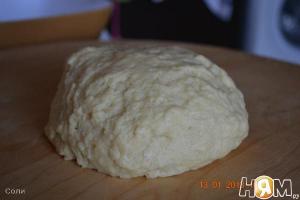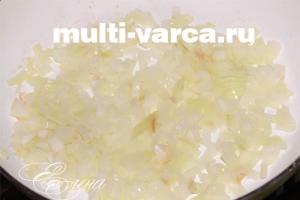What if you need to determine whether an egg is boiled or raw without breaking the shell? Knowledge of mechanics will help you successfully get out of this little difficulty.
The fact is that boiled and raw eggs do not rotate in the same way. This can be used to solve our problem. The test egg is placed on a flat plate and a rotational movement is imparted to it with two fingers (Fig. 39). A boiled (especially hard-boiled) egg rotates noticeably faster and longer raw. The latter is difficult to even make rotate; meanwhile, a hard-boiled egg spins so quickly that its outline merges to the eye into a white flattened ellipsoid and it can stand on its own sharp end.
Rice. 39. How to wrap an egg.
The reason for these phenomena lies in the fact that a hard-boiled egg rotates as a solid whole; in a raw egg, its liquid contents, not immediately receiving rotational movement, retard the movement of the solid shell due to its inertia; it acts as a brake.
Boiled and raw eggs also have different attitudes towards stopping rotation. If you touch a rotating boiled egg with your finger, it stops straightaway. A raw egg, having stopped for a moment, will rotate a little more after the hand is removed. This again happens due to inertia: the internal liquid mass in a raw egg still continues to move after the hard shell has come to rest; the contents of the boiled egg stop simultaneously with the stop of the outer shell.
Similar tests can be carried out in other ways. Wrap raw and boiled eggs with rubber rings “along the meridian” and hang them on two identical strings (Fig. 40). Twist both strings the same number of times and release. You will immediately notice the difference between a boiled and a raw egg. The boiled fish, having reached its initial position, will begin to twist the thread in the opposite direction by inertia, then unwind it again - and so on several times, gradually reducing the number of revolutions. A raw egg will turn once, twice and stop long before the hard-boiled egg calms down: the movements are inhibited by the liquid contents.

Rice. 40. How to distinguish boiled egg from raw by their rotation in a suspended form.
"Wheel of Laughter"
Open the umbrella, rest its end on the floor and rotate it by the handle; it will not be difficult for you to give it a fairly fast movement. Now throw a ball or crumpled paper inside the umbrella; the thrown object does not remain in the umbrella, but will be thrown out of it, which is commonly incorrectly called “centrifugal force” and which in reality is only a manifestation of inertia. The ball is thrown not in the direction of the radius, but tangentially to the path of circular motion.
This effect of rotational movement is the basis for a unique entertainment device - a “wheel of laughter” (Fig. 41), which can be seen, for example, in cultural parks. Visitors here have the opportunity to experience the effect of inertia for themselves. The audience is seated on a round platform - standing, sitting, lying down - as you wish. A motor hidden under the platform smoothly rotates it around a vertical axis, slowly at first, then faster and faster, gradually increasing the speed. And then, under the influence of inertia, everyone on the platform begins to slide towards its edges. At first this movement is barely noticeable, but as the “passengers” move away from the center and end up on circles of larger and larger radii, the speed, and therefore the inertia of movement, becomes more noticeable. No effort to stay in place leads to anything, and people are thrown off the “wheel of laughter.”

Rice. 41. "Wheel of Laughter." People on the spinning circle are thrown off the edges.
The globe is, in essence, the same “wheel of laughter”, only of gigantic size. The earth, of course, does not throw us off itself, but it still reduces our weight. And at the equator, where the rotation speed is greatest, there is a decrease weight from this reason, it reaches 1/300th of a share. And together with another reason (compression of the Earth), the weight of each body at the equator decreases, in general, by half a percent (i.e., by 1/200), so that an adult weighs about 300 g less at the equator than at the pole.
Ink swirls
Pierce a circle of smooth white cardboard in the center with a pointed match; you will get the pinwheel shown in Fig. 42 on the left is approximately half life size. It doesn't require much dexterity to make it spin on the pointed end of a match; Just twist the match between your fingers and quickly drop the pinwheel onto a smooth place.

Rice. 42. How ink drops spread on a spinning paper mug.
With such a turntable you can do a very revealing experiment. Before swirling it, apply a few small drops of ink to the top of the circle. Without letting them dry out, make the pinwheel spin. When it stops, look what happened to the drops: each of them spread into a spiral line, and all these curls together create a kind of vortex.
The resemblance to a vortex is not accidental. What do the ink swirls on a cardboard mug say? These are traces of the movement of ink drops. The drop undergoes the same thing that a person experiences on the rotating disk of the “wheel of laughter”. Carrying away from the center by the centrifugal effect, it ends up in places on the disk that have a greater circular speed than the speed of the drop itself. In these places, the circle slips out from under the drop and gets ahead of it. The situation occurs as if the drop lags behind the circle, retreats back from the radius. Its path is therefore curved, and we see on the mug a trace of curvilinear movement.
Air currents diverging from a place undergo the same thing. high pressure atmospheres (in "anticyclones") or converging to a place of low pressure (in "cyclones"). Ink swirls are a smaller version of these gigantic air vortices.
Deceived plant
With rapid rotation, the centrifugal effect can reach such a magnitude that it exceeds the effect of gravity. Here is an interesting experiment showing what a significant throwing force develops when an ordinary wheel rotates. We know that a young plant always directs its stem in the direction opposite to gravity, i.e., simply put, it grows upward. But make seeds germinate on the rim of a rapidly rotating wheel, as the English botanist Knight first did more than a hundred years ago. You will see an amazing thing: the roots of the sprouts will be directed outward, and the stems will be directed inward, along the radii of the wheel (Fig. 43).

Rice. 43. Bean seeds sprouted on the rim of a rotating wheel. The stems are directed towards the axis, the roots are directed outwards.
It’s as if we deceived the plant: instead of gravity, we forced another force to influence it, the action of which is directed outward from the center of the wheel. And since the sprout always stretches in the direction opposite to gravity, in this case it stretched inside the wheel, in the direction from the rim to the axle. Our artificial gravity turned out to be stronger than natural gravity [The modern view of the nature of gravity does not see a fundamental difference here, however.], and the young plant grew under its influence.
"Perpetual motion machines"
They often talk about “perpetual motion”, “perpetual motion” both in the literal and figurative sense of the word, but not everyone is aware of what, in fact, should be meant by this expression. A perpetual motion machine is an imaginary mechanism that continuously moves itself and, in addition, does some other useful work (for example, lifts a load). No one has been able to build such a mechanism, although attempts have been made to invent it for a long time. The futility of these attempts led to the firm conviction of the impossibility of perpetual motion and to the establishment of the law of conservation of energy - the fundamental statement of modern science. As for perpetual motion, this expression means continuous movement without doing work.

Rice. 44. An imaginary ever-moving wheel, invented in the Middle Ages.
In Fig. 44 depicts an imaginary self-propelled mechanism - one of the oldest projects of a perpetual motion machine, sometimes even now revived by unlucky fanatics of this idea. Folding sticks with weights at the ends are attached to the edges of the wheel. In any position of the wheel, the loads on its right side will be thrown further from the center than on the left; this half, therefore, must always pull over the left and thereby cause the wheel to rotate. This means that the wheel must rotate forever, at least until its axle wears out. That's what the inventor thought. Meanwhile, if you make such an engine, it will not rotate. Why is the inventor’s calculation not justified?
Here's why: although the weights on the right side are always further from the center, it is inevitable that the number of these weights is less than on the left.
Take a look at fig. 44: there are only 4 weights on the right, and 8 on the left. It turns out that the whole system is balanced; Naturally, the wheel will not rotate, but, after swinging several times, will stop in this position [The motion of such a system is described using the so-called theorem of moments.].
It has now been proven beyond doubt that it is impossible to build a mechanism that would forever move by itself while still doing some work. It is completely hopeless to work on such a task. In the past, especially in the Middle Ages, people unsuccessfully puzzled over its solution and spent a lot of time and labor on the invention of the “perpetual motion machine” (in Latin perpetuum mobile [Pronounced “perpetuum mobile”]). Possessing such an engine seemed even more tempting than the art of making gold from cheap metals.
In Pushkin’s “Scenes from Times of Knighthood,” such a dreamer was brought out in the person of Berthold.
“What is perpetuum mobile? – asked Martin.
“Perpetuum mobile,” Berthold answers him, “is perpetual motion.” If I find eternal motion, then I see no limits to human creativity... You see, my good Martin! Making gold is a tempting task, a discovery that may be interesting and profitable, but to find the perpetuum mobile... Oh!...”
Hundreds of “perpetual motion machines” were invented, but not a single one moved. In each case, as in our example, the inventor lost sight of some circumstance, which destroyed all plans.
Here is another example of an imaginary perpetual motion machine: a wheel with heavy balls rolling in it (Fig. 45). The inventor imagined that the balls on one side of the wheel, being always closer to the edge, would make the wheel spin with their weight.

Rice. 45. An imaginary perpetual motion machine with rolling balls.
Of course, this will not happen - for the same reason as with the wheel shown in Fig. 44. Nevertheless, in one of the American cities, a huge wheel of exactly this kind was built for advertising purposes, to attract public attention to the cafe (Fig. 46). Of course, this “perpetual motion machine” was imperceptibly driven by a skillfully hidden extraneous mechanism, although it seemed to the audience that the wheel was being moved by heavy balls rolling in the slots. There were other imaginary examples of perpetual motion machines of the same kind, which were exhibited at one time in the windows of watch stores to attract the public: all of them were imperceptibly set in motion by electric current.

Rice. 46. An imaginary perpetual motion machine in the city of Los Angeles (California), built for advertising.
An advertising “perpetual motion machine” once gave me a lot of trouble. My student workers were so amazed by him that they remained cold to my evidence of the impossibility of perpetual motion. The sight of the balls, which, rolling, rotated the wheel and rose upward with the same wheel, convinced them more than my arguments; they did not want to believe that the supposed mechanical miracle was powered by electric current from the city grid. What helped me out was that there was no current on weekends. Knowing this, I advised listeners to visit the window these days. They followed my advice.
- Well, did you see the engine? – I asked.
“No,” they answered me confused. - You can’t see him: he’s covered with a newspaper...
The law of conservation of energy again won their trust and never lost it again.
"Hook"
Quite a few Russian self-taught inventors worked to solve the tempting problem of a “perpetual motion machine.” One of them, the Siberian peasant Alexander Shcheglov, is described by M. E. Shchedrin in the story “Modern Idyll” under the name of “the tradesman Prezentov.” This is how Shchedrin talks about visiting this inventor’s workshop:
“The tradesman Presents was a man of about thirty-five, thin, pale, with large, thoughtful eyes and long hair that hung in straight strands to his neck. His hut was quite spacious, but a whole half of it was occupied by a large flywheel, so our company could hardly fit in it. The wheel was through, with spokes. Its rim, quite voluminous, was made of planks, like a box, inside of which there was emptiness. It was in this emptiness that the mechanism that constituted the inventor’s secret was located. The secret, of course, is not particularly wise, like bags filled with sand, which were left to balance each other. A stick was threaded through one of the spokes, which held the wheel motionless.
– We heard that you applied the law of perpetual motion to practice? – I started.
“I don’t know how to report,” he answered confused, “it seems as if...
-Can I take a look?
- Have mercy! For happiness...
He led us to the wheel, then led us around. It turned out that there was a wheel in front and behind.
- Is it spinning?
- It should seem to be spinning. It’s like he’s capricious...
-Can I remove the lock? - Presentov took out the stick - the wheel did not move.
- It’s capricious! - he repeated, - you need to give impetus. He grabbed the rim with both hands, turned it up and down several times and finally swung it with force and let it go - the wheel began to spin. It made several revolutions quite quickly and smoothly - one could, however, hear the sandbags inside the rim either pushing against the partitions or falling away from them; then it began to spin quieter, quieter; There was a crackling sound, a creaking sound, and finally the wheel stopped completely.
“It’s a hook, then,” the inventor explained confusedly and again tensed and waved the wheel. But the second time the same thing happened.
– Friction, perhaps, was not taken into account?
– And there was friction in the calculation... What is friction? It’s not from friction, it’s like this... Sometimes it seems to make you happy, and then suddenly... it becomes capricious, stubborn - and the Sabbath. If only the wheel was made from real material, otherwise it’s just some scraps.”
Of course, the point here is not in the “hook” or “real material”, but in the complexity of the main idea of the mechanism. The wheel spun a little from the “impetus” (impetus) that was given to it by the inventor, but inevitably had to stop when the energy imparted from the outside was exhausted to overcome friction.
Anything can happen in life, and it’s quite possible to forget and put the cooked one in the box with the raw eggs. And then remember this and groan - how can you now tell a boiled egg from a raw one without breaking it? A similar situation can occur for other reasons: the unknown egg lies separately from the raw ones. Did someone cook it or did they just wash it and put it on a napkin so it wouldn’t get dirty? Don't guess - just check!
How to distinguish a boiled egg from a raw one without breaking it
The most famous and proven method over the years is unscrew the egg. But not everyone can say with certainty in which case the egg rotates quickly and in which it slows down. And it’s not surprising if you didn’t understand the reasons for this behavior.
A boiled egg spins quickly, but a raw egg stops and does not want to rotate. Watch the video below to see how this happens:
What is the reason? The fact is that the boiled egg becomes one whole, so it rotates quickly. And when raw, the yolk dangles from side to side, which slows down and interferes with rotation.
By the way, using the same method you can determine how cooked the egg is. A hard-boiled egg will spin faster than a soft-boiled one.
You can also see the difference when stopping. When you touch a boiled egg, it immediately freezes in place. And the raw one continues to fluctuate a little by inertia.
We could stop here, but the article would not be complete. After all, there are 6 more ways to distinguish a boiled egg from a raw one.
- Shock– in raw eggs the yolk will move noticeably, but in boiled eggs there is nothing to move inside.
- Look at the light– in boiled eggs, the contents are hard and dense, so they are not at all transparent. And in raw eggs you can distinguish transparent parts and a darker yolk.
- Weigh, not even necessarily on the scales. Just hold the eggs in different hands and compare the sensations - boiled eggs are a little heavier than raw ones. Although this is rather dubious advice, since a lot depends on the size of the eggs and their size.
- Inspect– are there markings on the eggs (C-1, C-2), which are usually placed on store-bought eggs. On boiled eggs it is washed off, so you will immediately notice its absence.
- Smell the eggs– raw ones smell quite specific, so you will notice the difference. You can compare the aroma with a control egg, which is definitely raw.
- Break an egg or pierce it with a needle to see the contents. But this is only suitable if you are going to cook something with them in the near future. Because there are very strict rules that cannot be violated.
Mostly people use the first option, but sometimes there is no necessary surface for such “tricks”. Then it will be possible to use the remaining 6 methods to distinguish a boiled egg from a raw one without breaking it. And you definitely won't get into trouble by breaking raw egg, instead of boiled.
If by chance there were boiled and raw eggs side by side in the same basket, how can you tell which ones are raw and which ones are boiled?
Under the shell of a boiled egg there is a folded white, inside of which there is a boiled or semi-liquid yolk. In a raw egg, the white and yolk are a liquid substance. This is the main difference between a raw and boiled egg. But, unfortunately, the appearance of boiled and raw eggs is absolutely identical, which makes it much more difficult to separate eggs into raw and boiled.
How to distinguish a raw egg from a boiled one?
1. A simple and unpretentious way: break it.
This method can be used if you are going to cook something using raw eggs. In other cases, using this verification method is not recommended. A broken egg can cause food poisoning because it spoils much faster than an egg in its shell. Therefore, a broken egg should be used immediately for cooking.
2. Spin the egg.
Every housewife should know this secret. To distinguish a raw egg from a boiled one, you need to spin the egg on a flat surface. A boiled egg will spin faster than a raw one. The raw stuff will hardly be able to be promoted at all. This is the most reliable and proven way to determine whether an egg is raw or boiled, as a result of which all eggs will remain intact and undamaged.
This method of distinguishing a raw egg from a boiled one is based on the laws of mechanics. A boiled egg is dense inside and rotates as a solid whole object. A raw egg has liquid contents; it does not immediately receive rotational motion due to inertia. The surface rotates, but the internal contents do not yet. Therefore, it retards the movement of the hard shell and plays the role of a brake. The egg stops almost immediately.
Chicken eggs are a product that is used in the preparation of many dishes. Often, boiled eggs are required for preparation. Many housewives boil eggs, as they say, for future use and store them in the refrigerator. This makes it very convenient to make preparations when an invasion of guests is expected the next day or a large-scale New Year’s dinner is planned, where the tables will be laden with Olivier salad.
Let's imagine a situation where the eggs got mixed up or you forgot which shelf you put the boiled eggs on and which shelf the raw eggs were on. What to do in this case? How to distinguish from boiled?
Substance inside
The main difference between the two types of eggs will be the different consistency inside. In a boiled egg, the white and yolk will be hard - boiled, and in a raw egg - liquid. The difference between these substances distinguishes the two types of eggs.
But how can one distinguish this internal state of a chicken egg if it is securely hidden under the shell and not visible to the eye? How to distinguish a raw egg from a boiled one if the state of the white and yolk is completely unclear? You can, of course, label each egg with a marker so as not to get confused in the future, but it is unlikely that those who are busy cooking festive dinner housewives have time for this.
Method one is the simplest
Let's start with a simple, if not banal, method. The easiest way to distinguish between a raw and a boiled egg is to break these same eggs. In this case, it will be immediately clear what it is. Just don’t forget to place a plate under the egg before breaking it. What if, after all, there were not boiled eggs on that shelf, as you initially thought?
However, simplicity and banality can also hide some difficulties.
This method is only suitable if you were going to cook something today using chicken eggs. Let's say the plans already included a salad or, conversely, an omelet. And if you had no intention of cooking from these products today, we do not recommend this method. Storing raw eggs in broken form is a dangerous idea and can lead to food poisoning, stomach pain and intestinal problems. If a raw egg is broken, we either use it to prepare the dish or don’t use it at all.

Method two is more reliable
Using this method, any housewife, even a beginner and inexperienced one, will understand how to distinguish a raw egg from a boiled one. We take the “suspect” eggs and place them on a flat surface of the kitchen table. Then we carefully unwind each suspect and watch the result.
A raw egg, as a rule, makes no more than two revolutions and immediately stops. But its boiled counterpart will easily spin in front of you in a cheerful dance. The boiled egg will make at least ten circles before stopping. Why does this happen and what is the result of the experiment connected with?
Laws of mechanics
Remembering school and the basics When we spin an egg in its raw state, it turns out that we are simply spinning its shell and only a small part of the liquid contents, which is close to its walls. As soon as we stop the rotational movements, the force of internal friction of the viscous contents immediately stops the egg. The central part - the yolk - remains practically motionless at this moment.
With boiled food the situation is completely opposite. When an egg is boiled, it becomes, as it were, a single whole. The solid internal substance does not move separately, as in the case of a raw egg, but together with the shell. The egg begins to brake only when the force of sliding and friction on the kitchen surface decreases.

Now you know how to distinguish a raw egg from a boiled one. School knowledge, as it turns out, is not useless and even helps a lot in everyday life.
And we'll shake it up a little
There are a couple more ways to help determine the condition of the eggs. First, many people advise looking at the light. The boiled product will have denser, that is, darker contents.
The second option is to shake it. As we have already noted, a boiled egg will have a single boiled dense mass inside, so you should not feel any vibrations when shaking.
It has long been proven that proper nutrition– the basis of well-being and health. Therefore, many people refuse food that will do more harm than good. And if everything is clear with vegetables, fruits and boiled lean meat, there has long been a debate around eggs about what they contain more - healthy or harmful. On the one hand, eggs are a dietary product, low in calories, and on the other, systematic consumption of raw eggs can disrupt metabolism, and the yolks of boiled eggs contain a lot of cholesterol. To answer the question in what form is best to eat eggs, we suggest considering the differences between boiled and raw eggs.
Composition of raw and boiled eggs
In fact, the composition of eggs both boiled and raw is almost the same. The protein content in a raw egg is 12.7, fat - 11.5, and carbohydrates - 0.7. Total calories The calorie content is 157 kcal. A boiled egg differs little in composition: protein - 12.9, fats - 11.6, carbohydrates - 0.8, and the calorie content of the product is 160.
But, nevertheless, raw eggs are eliminated from the body quite quickly and are absorbed by 50%, while the absorption of boiled eggs is 90%.
In addition, when boiling, the density of eggs increases, and if you weigh an egg before and after boiling, it will turn out that the raw one is lighter than the boiled one.
How to understand where an egg is raw and where it is boiled experimentally
Many housewives are faced with the problem when, in a hurry, both boiled and raw eggs end up on the same shelf. And if at the moment it is fundamentally important to distinguish a boiled egg from a raw one, just remember your physics lessons.
If you spin an egg on a flat surface, the boiled one will spin quickly, but the raw one will spin much slower. This happens because inside a boiled egg the yolk and white are a continuous whole, but in a raw egg there is a liquid substance in the hard shell that “unwinds” gradually, and as a result slows down the entire process of egg rotation. In addition, if you touch a boiled egg with your finger, it will immediately stop, but a raw egg will be prevented from stopping quickly by the same liquid substance inside, which will continue to move for some time by inertia.

There is another method - weighing, but it is only suitable for eggs of the same type (since in this case they are the same in weight). A boiled egg will be heavier than a raw one.
Conclusions website
- A boiled egg has more calories than a raw egg, although not by much.
- Raw eggs are absorbed by the body better than boiled ones.
- The density of a boiled egg is greater than that of a raw egg.
- If you spin a raw egg on the surface, it will not begin to rotate immediately and more slowly than a boiled one. A boiled egg will also stop in one moment, while it will take a little time for a raw egg to stop.
- Raw eggs of the same type are lighter than boiled eggs.







